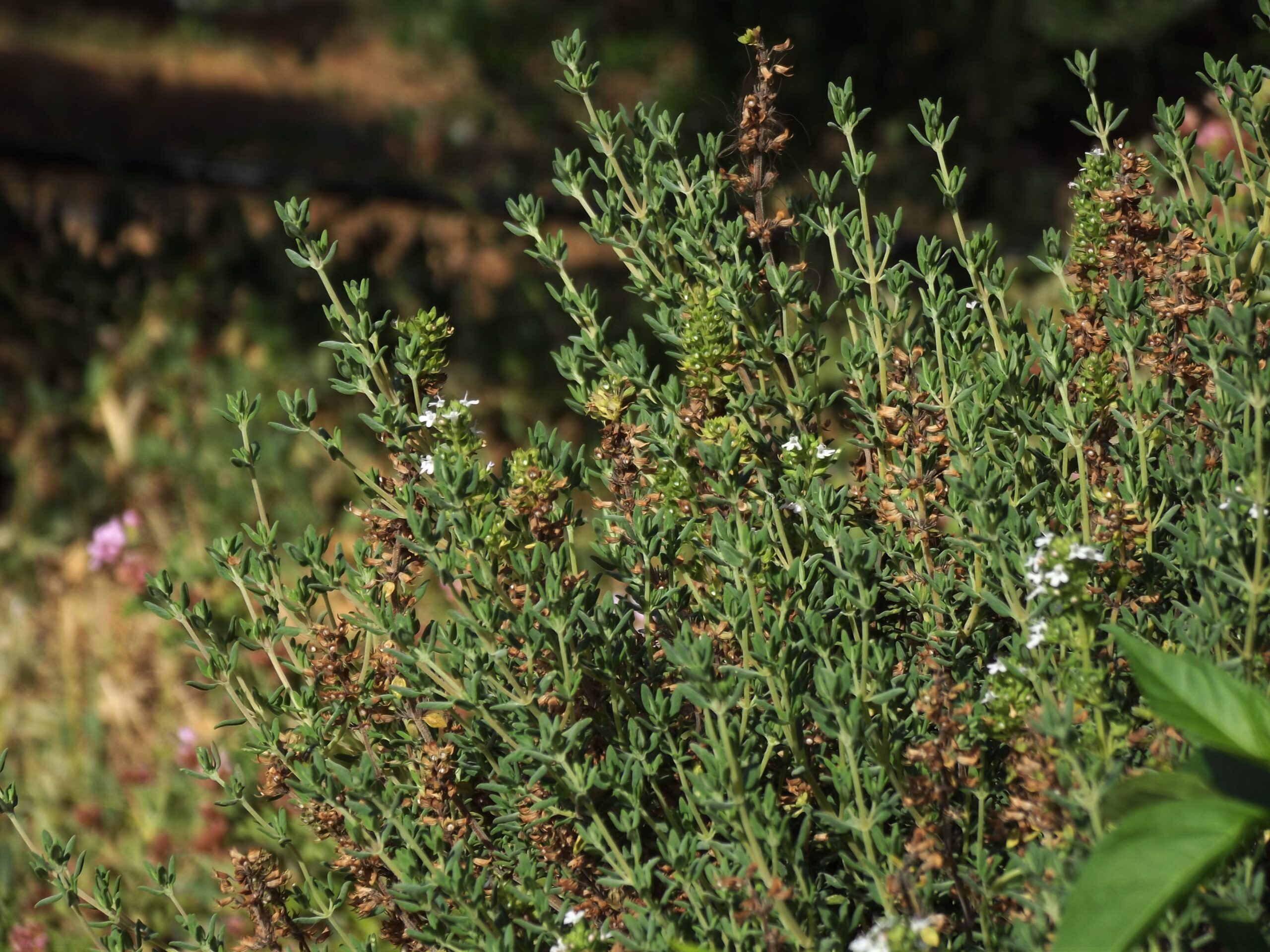Thyme is a versatile herb that dons many hats. Did you know there are over 350 species of thyme? That’s right; when it comes to choosing thyme for your next culinary masterpiece or landscaping project, you’re not just limited to the common garden variety.
Thyme, a fragrant and versatile herb, comes in a spectrum of flavors and forms. Whether you’re a home cook, a professional chef, or a gardening enthusiast, understanding the different types of thyme can significantly enhance your dishes and landscapes.
In this article, I intend to unravel the fascinating world of thyme—its different types, distinctive features, and culinary uses.
9 Different Types of Thyme
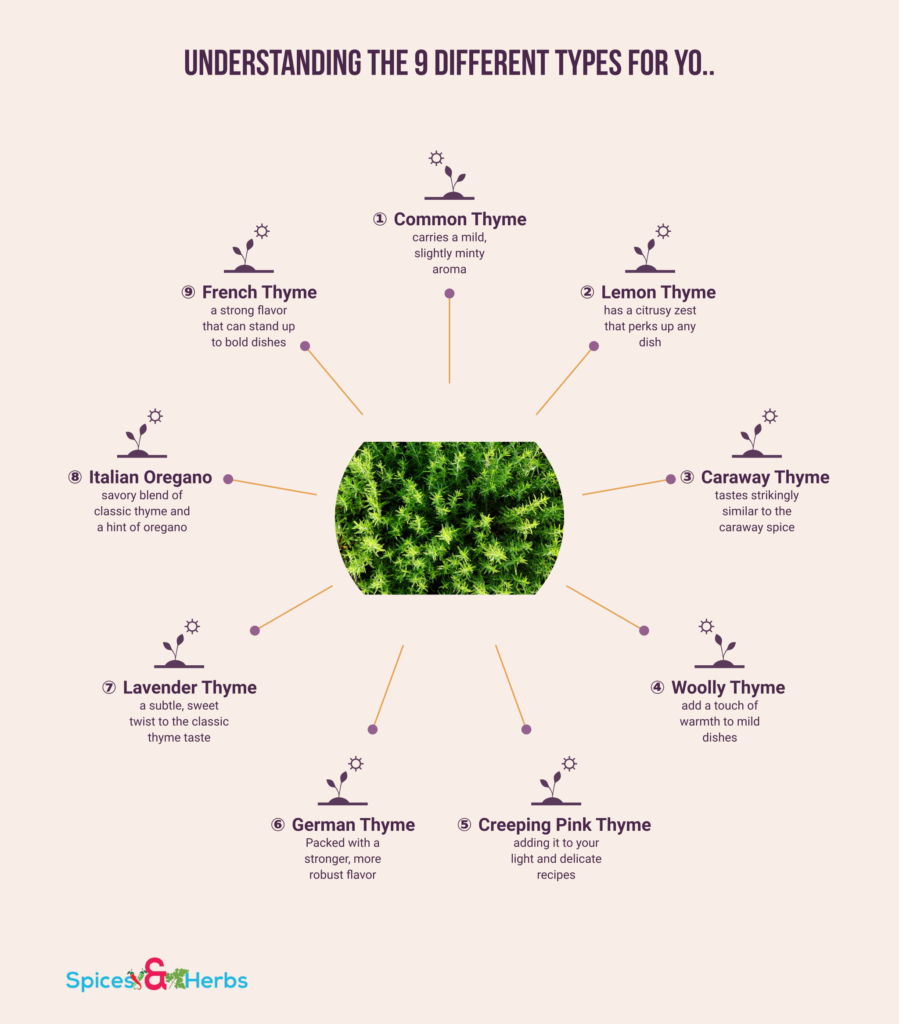
I know your curious mind must be wondering what are the different types of thyme. Well, several varieties have become popular over the years and can be found in specialty stores worldwide. Let’s quickly list them out:
① Common Thyme
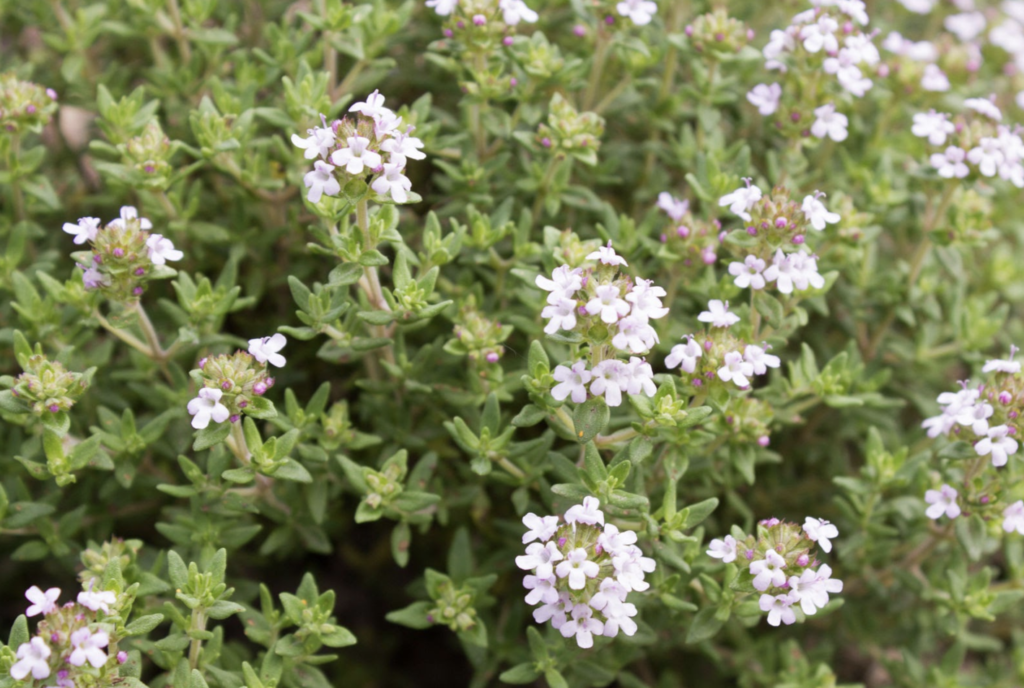 Common thyme is the variety you’ll most likely encounter at your local grocery store. It’s a kitchen staple, adds a lovely depth of flavor to dishes, and carries a mild, slightly minty aroma. You’d be surprised to know that it’s not just handy in the kitchen but also quite the looker in the garden!
Common thyme is the variety you’ll most likely encounter at your local grocery store. It’s a kitchen staple, adds a lovely depth of flavor to dishes, and carries a mild, slightly minty aroma. You’d be surprised to know that it’s not just handy in the kitchen but also quite the looker in the garden!
With its tiny, gray-green leaves and beautiful pink flowers, common thyme is a charmer in any herb or flower garden. What’s more, it’s a favorite amongst bees, so if you’re a friend to these little pollinators, common thyme could be your new go-to herb!
② Lemon Thyme
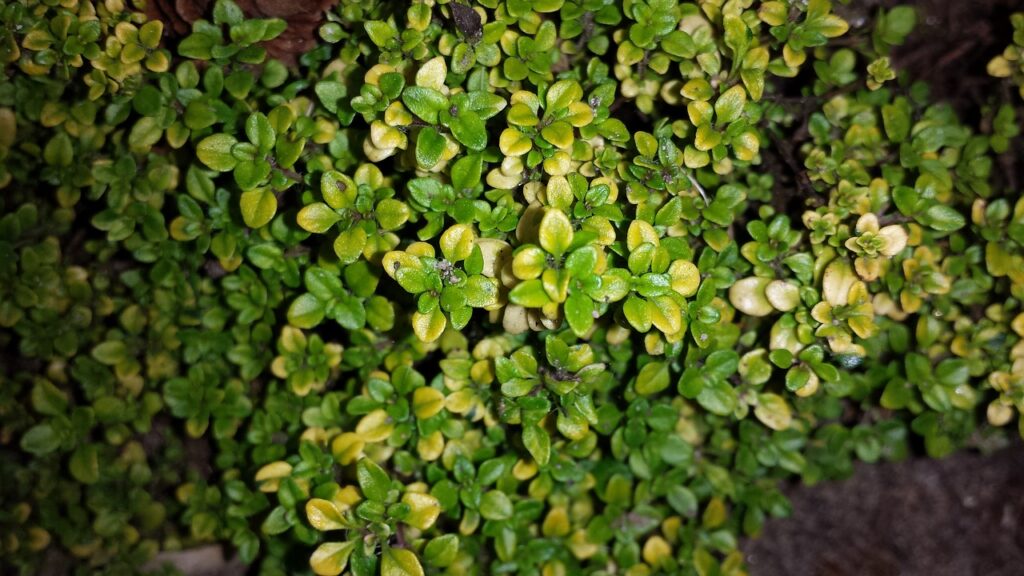 As the name suggests, Lemon Thyme has a citrusy zest that perks up any dish it graces. Imagine sipping your aromatic herbal tea, its flavor heightened with the refreshing notes of lemon thyme, or grilling a piece of fish marinated in a lemon thyme-infused oil. Tempting, isn’t it? Well, that’s the magic of Lemon Thyme.
As the name suggests, Lemon Thyme has a citrusy zest that perks up any dish it graces. Imagine sipping your aromatic herbal tea, its flavor heightened with the refreshing notes of lemon thyme, or grilling a piece of fish marinated in a lemon thyme-infused oil. Tempting, isn’t it? Well, that’s the magic of Lemon Thyme.
And guess what? It’s not just about the flavor. This thyme variant is a feast for the eyes too. With its glossy green leaves and summer-ready, pale pink flowers, Lemon Thyme is a delight to have in your herb garden or flower bed. You know what they say: An herb that’s both flavorful and visually appealing is a win-win!
③ Caraway Thyme
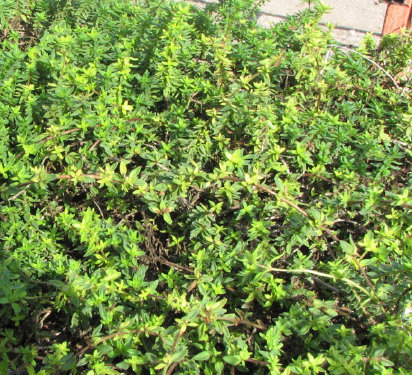 Isn’t it fantastic when you get a two-for-one deal? Meet Caraway Thyme, where you indeed get just that! This unique variety tastes strikingly similar to the caraway spice, hence its name. Imagine using it in your savory bread recipes or stews for that extra punch of flavor.
Isn’t it fantastic when you get a two-for-one deal? Meet Caraway Thyme, where you indeed get just that! This unique variety tastes strikingly similar to the caraway spice, hence its name. Imagine using it in your savory bread recipes or stews for that extra punch of flavor.
Caraway thyme doesn’t hold back on the looks, either. It’s a low-growing variety that spreads across the ground, making it an ideal choice for your rock gardens or borders. But here’s the exciting part – it’s not just a culinary star and garden beauty.
Caraway thyme is also well-known for its medicinal properties. It’s been traditionally used for digestive problems, coughs, and even as an antiseptic. Therefore, the next time you plan your herb garden or create a new dish, remember Caraway Thyme; it’s a real gem!
④ Woolly Thyme
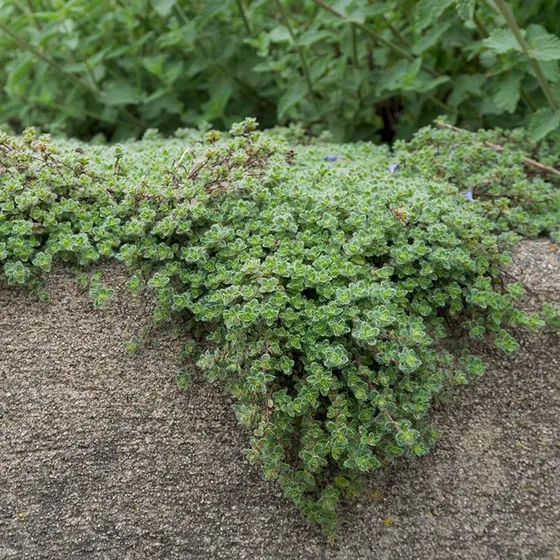 Hey, have you heard of Woolly Thyme? No, it’s not a fluffy animal, but it sure does sound like one, right? This variety of thyme is quite a game-changer. It’s called ‘Woolly’ because its soft, fuzzy leaves make it look like it’s wearing a cozy grey sweater. Cute, isn’t it? And it’s not just about aesthetics, oh no! Despite its fluffy exterior, Woolly Thyme is as tough as they come. It’s drought-resistant and thrives in rocky, dry soils.
Hey, have you heard of Woolly Thyme? No, it’s not a fluffy animal, but it sure does sound like one, right? This variety of thyme is quite a game-changer. It’s called ‘Woolly’ because its soft, fuzzy leaves make it look like it’s wearing a cozy grey sweater. Cute, isn’t it? And it’s not just about aesthetics, oh no! Despite its fluffy exterior, Woolly Thyme is as tough as they come. It’s drought-resistant and thrives in rocky, dry soils.
Due to its milder flavor, it’s not typically used in cooking, but it can still add a touch of warmth to mild dishes. It’s pretty good for tea too! You just steep the leaves in hot water, and voila, you’ve got yourself a soothing cup of Woolly Thyme tea!
But hey, there’s more. Woolly Thyme is also known for its medicinal uses. It’s been used in traditional medicine for its antiseptic properties and can be applied topically to minor wounds and cuts. It’s also believed to be soothing and can help with sleep issues when used in aromatherapy.
⑤ Creeping Pink Thyme
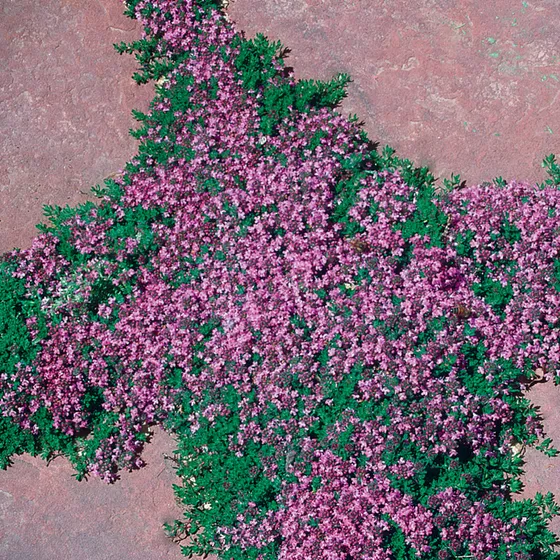 Meet Creeping Pink Thyme, the showstopper of the thyme family. This little beauty is all about the drama! It gets its name from its growth habit, spreading out in a carpet-like fashion, and the exquisite pink flowers that bloom in summer. It’s not just a pretty face, though. Creeping Pink Thyme is a tough cookie that can stand up to dry, rocky soils and intense sunshine.
Meet Creeping Pink Thyme, the showstopper of the thyme family. This little beauty is all about the drama! It gets its name from its growth habit, spreading out in a carpet-like fashion, and the exquisite pink flowers that bloom in summer. It’s not just a pretty face, though. Creeping Pink Thyme is a tough cookie that can stand up to dry, rocky soils and intense sunshine.
Now, I know what you’re thinking, “But can I use it in my cooking?” Unlike its cousins, Creeping Pink Thyme isn’t typically used in the kitchen. Its flavor is milder compared to other varieties. But hey, that doesn’t mean it can’t jazz up your dish! You can try it by adding it to your light and delicate recipes.
Remember, Creeping Thyme is an excellent choice if you’re looking for a ground cover that’s both functional and beautiful. Planting this in your garden would be like rolling out the pink carpet for your guests.
⑥ German Thyme
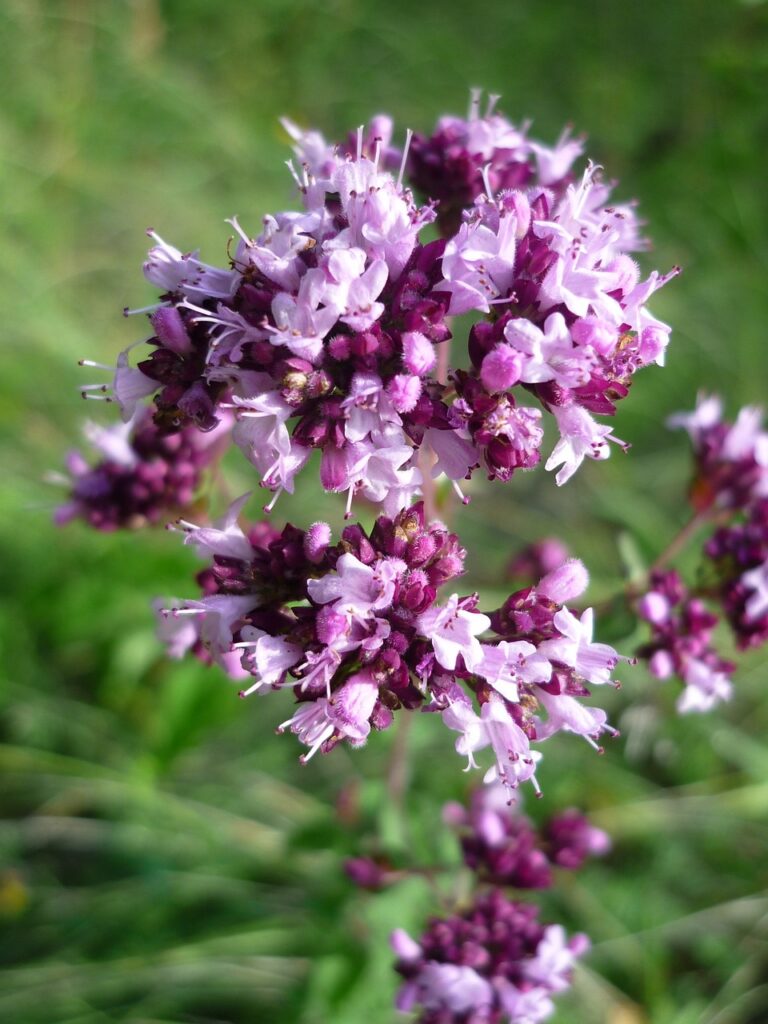 Have you ever heard of German Thyme? If not, allow me to introduce you to this culinary superstar. German thyme, also known as Winter Thyme, is like that trusty friend who’s got your back, no matter the weather.
Have you ever heard of German Thyme? If not, allow me to introduce you to this culinary superstar. German thyme, also known as Winter Thyme, is like that trusty friend who’s got your back, no matter the weather.
Packed with a stronger, more robust flavor compared to common thyme, it’s a favorite among chefs for winter recipes. Imagine a bowl of hearty stew or roasted meat elevated with a sprinkle of German Thyme. Yum, right?
But let’s not forget its looks. This variety has broader, darker leaves, and its tiny lilac flowers can add color to your winter garden. It’s like having a piece of summer all year round! And guess what? It’s super hardy and can withstand those chilly winter months better than other varieties.
Not just a culinary gem and a garden favorite, German Thyme is also known for its medicinal properties. Some folks use it to soothe coughs and sore throats during the cold season.
⑦ Lavender Thyme
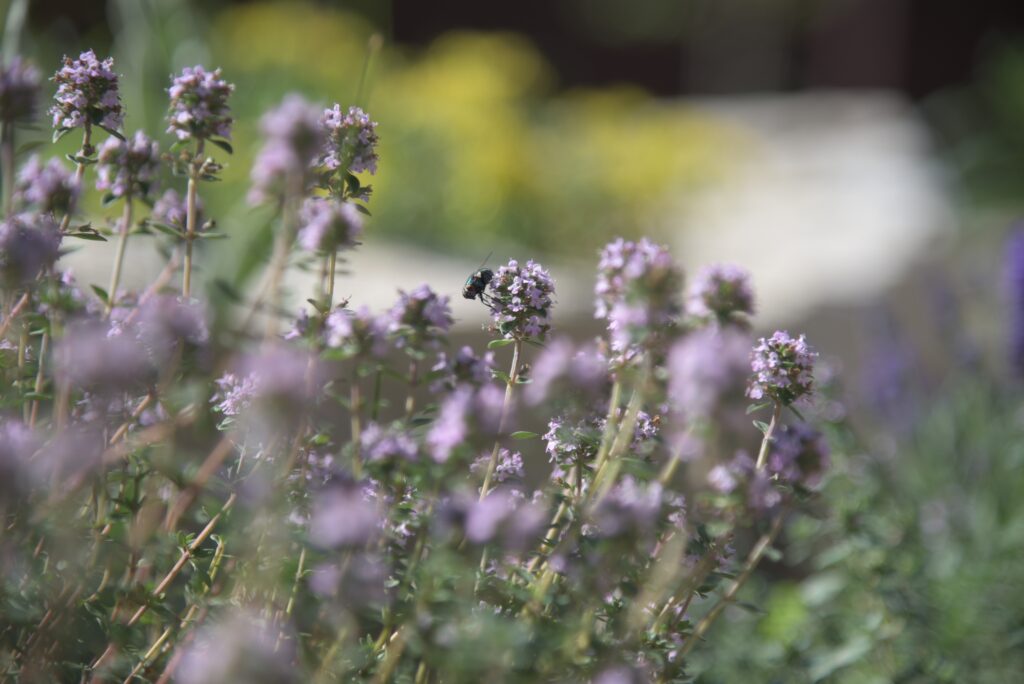 Ah, Lavender Thyme! It’s like the best of both worlds. This one’s a real stunner, with its pale purple flowers that give off a soft, enchanting lavender scent. If you thought thyme was just for the kitchen, guess again, my friend! Just picture this: a warm summer evening, you’re out in your garden, and there’s that gentle, calming aroma of Lavender Thyme wafting in the air. Sounds like a little slice of heaven, right?
Ah, Lavender Thyme! It’s like the best of both worlds. This one’s a real stunner, with its pale purple flowers that give off a soft, enchanting lavender scent. If you thought thyme was just for the kitchen, guess again, my friend! Just picture this: a warm summer evening, you’re out in your garden, and there’s that gentle, calming aroma of Lavender Thyme wafting in the air. Sounds like a little slice of heaven, right?
And hey, let’s not forget about flavor, either. Lavender Thyme brings a subtle, sweet twist to the classic thyme taste. It’s just the thing to add an unexpected touch to your favorite dishes. A sprinkling over your roast chicken? Yes, please!
But, you know, it’s not just a pretty face and a tasty herb. Like its thyme siblings, Lavender Thyme also has its share of medicinal properties. It’s been used in traditional herbal medicine for its calming effect, and some folks swear by it as a natural remedy for sleep issues.
⑧ Italian Oregano Thyme
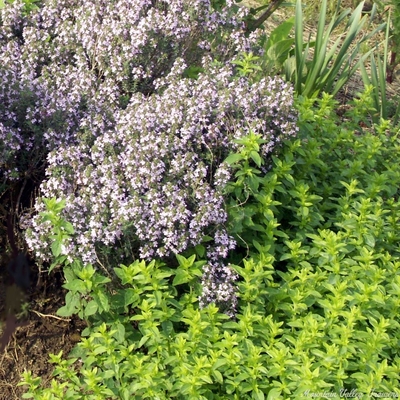 You’d absolutely want to include this versatile herb in your garden. It has this unique flavor: a savory blend of classic thyme and a hint of oregano. It can make a simple pasta dish sing or turn a roast chicken into a gourmet delight. Your taste buds are going to thank you!
You’d absolutely want to include this versatile herb in your garden. It has this unique flavor: a savory blend of classic thyme and a hint of oregano. It can make a simple pasta dish sing or turn a roast chicken into a gourmet delight. Your taste buds are going to thank you!
Italian Oregano Thyme is not just a master chef; it’s a garden superstar, too. It’s got these delightful tiny pink flowers that can charm the socks off anyone, and it loves basking in the sun. And the best part? It’s pretty hardy. So, even if you’re not the best gardener, this thyme variety would still thrive.
⑨ French Thyme
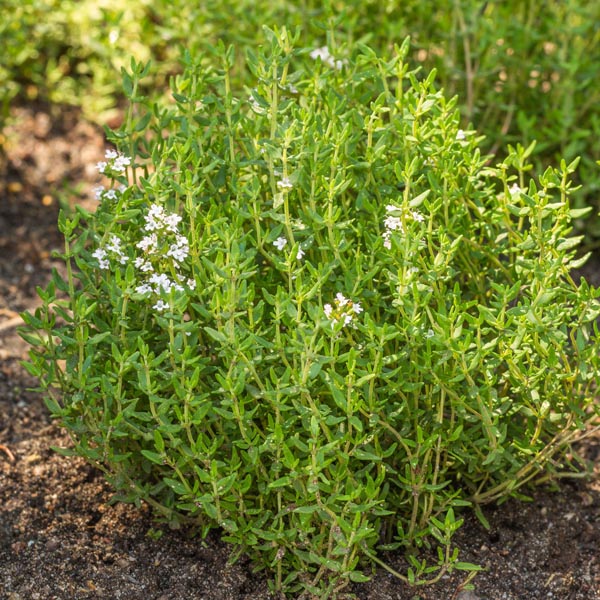 Last but definitely not least, let me introduce you to French Thyme. This one’s quite the celebrity in the herb world – it was even featured in Julia Child’s cookbook! French thyme is a classic culinary workhorse with a strong flavor that can stand up to bold dishes. Think roasted lamb, beef stew, and more! Plus, it pairs perfectly with other herbs like rosemary and sage. But of course, its classic thyme flavor is the star here.
Last but definitely not least, let me introduce you to French Thyme. This one’s quite the celebrity in the herb world – it was even featured in Julia Child’s cookbook! French thyme is a classic culinary workhorse with a strong flavor that can stand up to bold dishes. Think roasted lamb, beef stew, and more! Plus, it pairs perfectly with other herbs like rosemary and sage. But of course, its classic thyme flavor is the star here.
And let’s not forget the looks. French Thyme boasts beautiful pink-tipped green leaves that can add a touch of style to your garden. And hey, if you’re looking for a showstopper, this one’s a great choice. Just imagine lush beds of French Thyme!
Like its siblings, French Thyme is also believed to have medicinal properties. It’s been used in traditional herbal medicine for its antiseptic and anti-inflammatory effects. So, it’s more than just a flavor enhancer; it could also be an effective remedy!
Thyme in Cooking
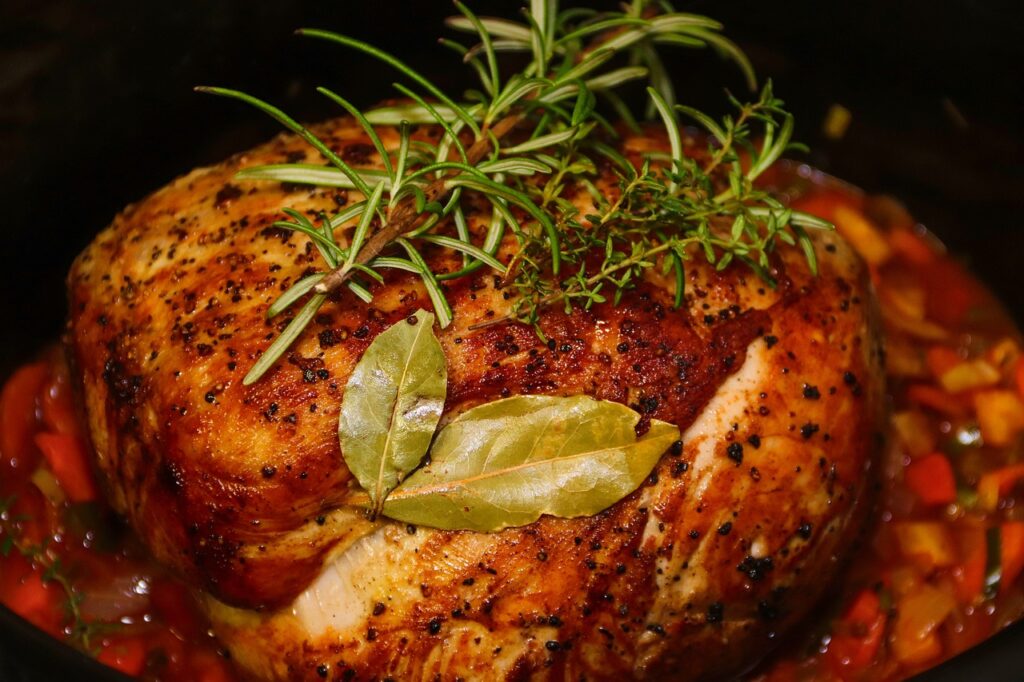
So, you’ve got all the knowledge about the different types of thyme, and now you’re wondering, “How do I use them in my culinary adventures?” Well, don’t worry; I’ve got you covered. Here’s the lowdown on making the most out of this versatile herb.
🌿 Popular Dishes
Thyme is a key player in the culinary world, and it’s not hard to see (or taste) why. From savory stews to aromatic teas, its distinct taste can elevate a dish like no other. Take Woolly Thyme, for instance. It’s like a magic potion in your tea, adding a comforting warmth that’s just what you need on a chilly evening.
And then there’s German thyme. Remember the hearty winter recipes I mentioned earlier? Well, it’s the secret ingredient that can make your mouth water. That robust flavor can take your stew or roast meat from good to “Can I have seconds, please?”
French Thyme? Fantastic in bold dishes. Italian Oregano Thyme? Your pasta’s best friend. And let’s remember Lavender Thyme. Just sprinkle over your roast chicken, and you’ll have a meal fit for a culinary queen (or king)!
🌿 Pairing Tips with Other Ingredients
Now, the sky’s the limit when it comes to pairing thyme with other ingredients. Its flavor profile is so versatile that it can complement various ingredients. But if you want some quick tips, here they are:
- With meats: Thyme pairs beautifully with almost all kinds of meat – beef, chicken, lamb, you name it. And if you’re grilling, you’re in for a treat! Sprinkle some thyme, and the smoky, herby flavor is just divine.
- With vegetables: Roast veggies with a bit of thyme, and you’ll see why this herb is a superstar. Potatoes, carrots, bell peppers – thyme’s earthy flavor is the perfect match.
- With other herbs: Thyme gets along well with fellow herbs too. Pair it with rosemary plant, sage, or parsley; you’ve got a winning combo.
- With fruits: Yes, you heard it right! Thyme can be a surprising but delightful companion to fruits. Think grilled peaches or a refreshing watermelon salad with a sprinkle of thyme.
Growing and Caring for Thyme
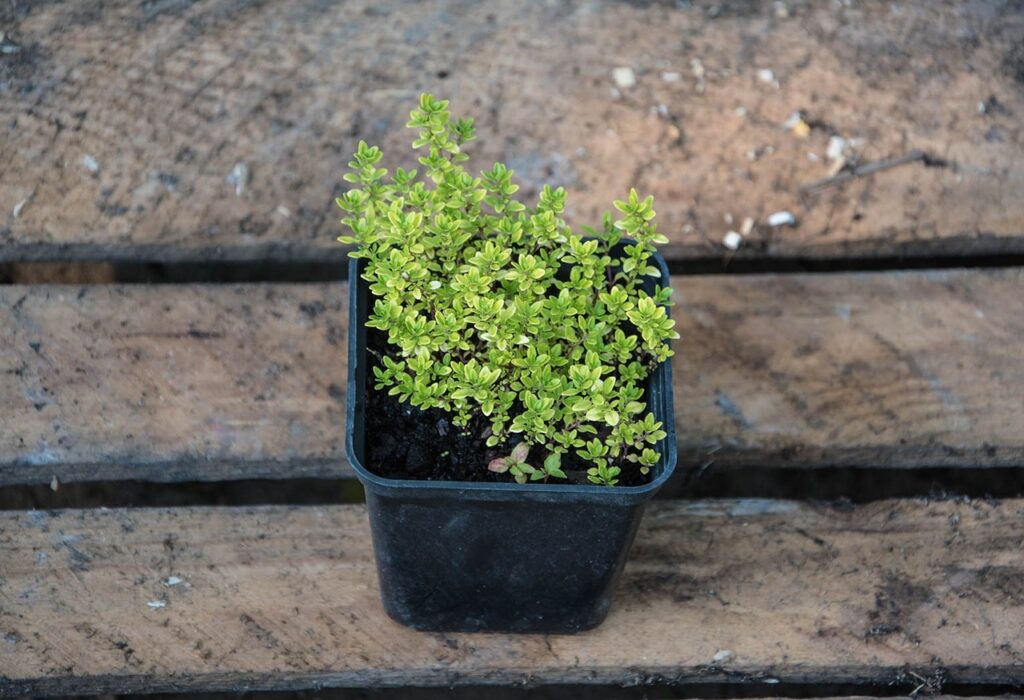
Thyme is one of those low-maintenance herbs – it doesn’t need a lot of fussing over. But if you want to get the best out of your thyme plants, here are a few tips:
🌿 Preferred Conditions
Thyme prefers full sun exposure, but it can also tolerate a little bit of shade. What this means is that you can plant it almost anywhere in your garden, be it in a sun-drenched corner or a slightly shady nook – thyme will roll with it! And the soil? Well, thyme isn’t too finicky about it, either. It does prefer well-drained soil, but apart from that, it can handle a variety of soil types. So whether your garden’s got sandy or loamy soil, thyme’s got you covered.
One thing to remember is that it doesn’t like to sit in waterlogged soil. If you’ve got heavy clay soil or live in a region with heavy rainfall, consider growing thyme in raised beds or pots. This way, you have better control over the drainage.
And did I mention thyme is drought-tolerant? Yup, it’s a true survivor. Once established, it can pretty much fend for itself even in dry conditions. So, if you forget to water your plants or are heading out for a vacation, your thyme plant won’t throw a fit.
🌿 Pests and Diseases
While thyme boasts a reputation for being quite resilient, it is not entirely immune to pests and diseases. The most common insect pests you may encounter are aphids and spider mites. These tiny critters can suck the sap out of your thyme plants, causing the leaves to turn yellow and distort. If you notice any signs of these pests, consider treating your plants with a safe insecticidal soap or neem oil.
As for diseases, thyme is susceptible to fungal issues like root rot, particularly if the soil is too damp. This can cause the plant to wilt and potentially die. To prevent this, ensure your thyme is planted in well-draining soil and avoid overwatering.
Lastly, thyme can occasionally be affected by Thyme Blight, a disease that causes browning or bleaching of the plant’s leaves. Regular pruning can help promote good air circulation, which in turn, helps to prevent this disease.
🌿 Pruning and Harvesting
Pruning and harvesting are essential steps to keep your thyme plants growing long. Pruning helps promote new growth, while harvesting ensures you get the best flavor out of your herbs.
When it comes to pruning, be sure to cut off any dead or damaged leaves. You can do this as soon as they start to brown or when they reach 4-6 inches in length. This will encourage healthy and full growth.
As for harvesting, it’s best to wait until the flowers start to bloom before you snip off a few leaves. You can also harvest the entire sprig if you need more thyme for your dishes. After all, a little bit goes a long way.
Frequently Asked Questions
Q: What are the different thyme varieties used in cooking?
Numerous thyme varieties are popular in cooking, each offering its unique flavor profile. Some well-loved types include German Thyme, known for its robust flavor for hearty stews, French Thyme, used in bold dishes; and Italian Oregano Thyme, a beloved addition to pasta sauces. Other varieties like Woolly Thyme and Lavender Thyme are also used for their distinct, aromatic qualities.
Q: How is fresh thyme used in culinary practices?
Fresh thyme is a versatile culinary herb that can be used in a myriad of dishes. Its earthy flavor pairs beautifully with meats, vegetables, and even fruits. Whether you are roasting meat, grilling vegetables, or crafting a fruity salad, fresh thyme can enhance the dish with its unique flavor.
Q: How does the use of dried thyme differ from fresh thyme in cooking?
While fresh thyme offers a delicate and vibrant flavor, dried thyme provides a more concentrated and robust taste. Dried thyme is often preferred in slow-cooked dishes such as stews, where it can infuse the dish with its rich aroma over time, whereas fresh thyme is perfect for dishes that require a more subtle hint of herbiness.
Q: Can wild thyme be used as a culinary herb?
Yes, wild thyme is indeed a popular culinary herb. Its fragrant, slightly minty flavor makes it an excellent addition to a variety of dishes. But aside from its culinary uses, it also features beautiful green foliage that can be a delightful addition to a rock garden.
Q: Can I plant thyme indoors?
Yes, you can plant thyme indoors and enjoy the herb’s wonderful flavor all year round. It thrives in a sunny spot near a window and requires little maintenance – making it an ideal choice for novice gardeners. Keep in mind that you’ll need to provide adequate drainage and water frequently so that your plants don’t experience root rot due to excessive moisture.
Final Words
A journey through the world of thyme is indeed a flavorful odyssey. Whether you’re a culinary enthusiast looking to spice up your dishes, a home gardener seeking low-maintenance plants, or a nature lover intrigued by the resilience of this humble herb, thyme offers something for everyone. From German Thyme to Italian Oregano Thyme, there’s a variety to suit every palate and every dish. So, why wait? Start exploring the myriad possibilities that thyme has to offer. Remember, as the saying goes, “There is always thyme for a flavorful adventure!”

